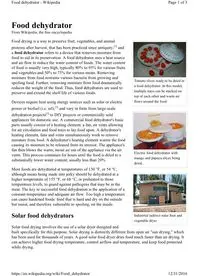Table Of ContentTomato slices ready to be dried in
a food dehydrator. In this model,
multiple trays can be stacked on
top of each other and warm air
flows around the food.
Electric food dehydrator with
mango and papaya slices being
dried.
Industrial indirect solar fruit and
vegetable dryer
Food dehydrator
From Wikipedia, the free encyclopedia
Food drying is a way to preserve fruit, vegetables, and animal
proteins after harvest, that has been practiced since antiquity,[1] and
a food dehydrator refers to a device that removes moisture from
food to aid in its preservation. A food dehydrator uses a heat source
and air flow to reduce the water content of foods. The water content
of food is usually very high, typically 80% to 95% for various fruits
and vegetables and 50% to 75% for various meats. Removing
moisture from food restrains various bacteria from growing and
spoiling food. Further, removing moisture from food dramatically
reduces the weight of the food. Thus, food dehydrators are used to
preserve and extend the shelf life of various foods.
Devices require heat using energy sources such as solar or electric
power or biofuel (i.e. oil),[2] and vary in form from large-scale
dehydration projects[3] to DIY projects or commercially sold
appliances for domestic use. A commercial food dehydrator's basic
parts usually consist of a heating element, a fan, air vents allowing
for air circulation and food trays to lay food upon. A dehydrator's
heating element, fans and vents simultaneously work to remove
moisture from food. A dehydrator's heating element warms the food
causing its moisture to be released from its interior. The appliance's
fan then blows the warm, moist air out of the appliance via the air
vents. This process continues for hours until the food is dried to a
substantially lower water content, usually less than 20%.
Most foods are dehydrated at temperatures of 130 °F, or 54 °C,
although meats being made into jerky should be dehydrated at a
higher temperature of 155 °F, or 68 °C, or preheated to those
temperature levels, to guard against pathogens that may be in the
meat. The key to successful food dehydration is the application of a
constant temperature and adequate air flow. Too high a temperature
can cause hardened foods: food that is hard and dry on the outside
but moist, and therefore vulnerable to spoiling, on the inside.
Solar food dehydrators
Solar food drying involves the use of a solar dryer designed and
built specifically for this purpose. Solar drying is distinctly different from open air "sun drying," which
has been used for thousands of years. A good solar food dryer dries food much faster than air drying. It
can achieve higher food drying temperature, control airflow and temperature, and keep food protected
while drying.
Page 1 of 3
Food dehydrator - Wikipedia
12/31/2016
https://en.wikipedia.org/wiki/Food_dehydrator
Food drying is an excellent solar energy application since food drying primarily requires heat, and solar
radiation is easily converted to heat. A clear or translucent glazing allows sunlight to enter an enclosed
chamber where it is converted to heat when it strikes a dark interior surface. Airflow is typically
achieved with natural convection (warm air rises). Adjustable venting allows regulation of airflow and
temperature.
Solar food drying is effective and practical in most of the populated places of the world.[4] A general rule
is that, if you can grow a successful vegetable garden, then there is enough solar energy to dry the food
you produce (some overcast, northern maritime climates are the exception).
Some solar food dryer designs employ a separate solar collector to generate the heated air, which is then
directed into a food chamber or cabinet. This type of solar food dehydrator is called an indirect solar
dryer.[5][6][7] Other designs combine the collector and food cabinet and allow direct heating of food (these
are called direct solar dryers).[8][9][10][11] It is said that the indirect dryers allow much better drying, but
the downside is their larger size. Backup electric heating can be incorporated into some solar food
dehydrators to provide an alternative heat source if the weather changes. Solar food dehydrators are
often cited as viable tools in the search for agricultural sustainability and food security.[12]
See also
◾ List of dried foods
References
1. "Historical Origins of Food
Preservation." (http://www.uga.edu/nchfp/publications/nchfp/factsheets/food_pres_hist.html) University of
Georgia, National Center for Home Food Preservation (http://www.uga.edu/nchfp). Accessed June 2011.
2. "Food dehydrator Techniques". dehydratory.com. Retrieved 17 October 2015.
3. "Samuel Saraiva Project: Massive Food Dehydration to End World
Hunger." (http://findarticles.com/p/articles/mi_pwwi/is_200804/ai_n25161183/?tag=rbxcra.2.a.55) The CBS
Interactive Business Network (http://www.bnet.com). Accessed June 2011.
4. Eben Fodor (2006). The Solar Food Dryer: How to Make and Use Your Own Low-Cost, High Performance,
Sun-Powered Food Dehydrator. New Society Publishers. ISBN 978-0865715448.
5. Appalachian Dryer
(http://appropriatetec.appstate.edu/sites/appropriatetec.appstate.edu/files/HPImprovingSolarFoodDryers.pdf),
1999
6. Zerbe, Leah, [Want Summer Flavor to Last All Year? Use a Solar Food Dehydrator
http://www.rodale.com/solar-food-dehydrator], Rodale Dryer, July 15, 2011
7. "What's the Best Solar Food Dryer?". Root Simple.
8. "Eco-Tips". Global Sustainable Solutions.
9. Fodor's solar dryer, design 2
(http://www.motherearthnews.com/~/media/Images/MEN/Editorial/Articles/Magazine%20Articles/1993/02-
01/How%20to%20Build%20a%20Food%20Dehydrator/136-054-01-pix1.jpg)
10. North Dakota State University direct solar dryer (http://www.ag.ndsu.edu/aben-plans/6244.pdf)
11. The DuckMaster. "The RunnerDuck Dehydrator, step by step instructions.". runnerduck.com.
12. Scanlin, Dennis (Feb/March 1997). "The Design, Construction and Use of an Indirect, Through-Pass, Solar
Food Dryer." Home Power magazine, Issue No. 57, pp. 62–72.
Page 2 of 3
Food dehydrator - Wikipedia
12/31/2016
https://en.wikipedia.org/wiki/Food_dehydrator
Retrieved from "https://en.wikipedia.org/w/index.php?title=Food_dehydrator&oldid=720316970"
Categories: Food preparation appliances
Dried foods
◾ This page was last modified on 15 May 2016, at 02:47.
◾ Text is available under the Creative Commons Attribution-ShareAlike License; additional terms
may apply. By using this site, you agree to the Terms of Use and Privacy Policy. Wikipedia® is a
registered trademark of the Wikimedia Foundation, Inc., a non-profit organization.
Page 3 of 3
Food dehydrator - Wikipedia
12/31/2016
https://en.wikipedia.org/wiki/Food_dehydrator

